Aeonium arboretum
Aeonium
An easy to grow succulent that is a prime choice along the coast. Provide with afternoon shade in warm inland regions. Not overly tolerant to cold, container culture is a good option to enable moving it to a sheltered location before winter frosts. Many selections are available. See 'Zwartkop', which is described in this database. Canopy coverage: 3 square feet.
[Read More]Agave 'Blue Glow'
Blue Glow Agave
An agave grown for its striking blue-green leaves. If possible, locate where you can view it when backlit by the sun. Prefers afternoon shade in hot-summer regions. Flowering is sporadic and make take years. Canopy coverage: 7 square feet.
[Read More]Agave americana
Century Plant, American Agave
Select and plant this Agave after some consideration. The small size at planting time can become a towering, wide-spreading plant. Locate well away from paths and entries. 'Marginata' features leaves with distinctive cream to yellow margins. 'Mediopicta Alba' leaves have a cream to white center stripe. (See photos.) Produces prolific offsets to replace plants that will die after flowering. Canopy coverage: 113 square feet.
[Read More]Agave attenuata
Foxtail Agave
Provides the most subtropical appearance of all Agaves. Accepts full sun in coastal regions; requires some shade in hot desert and inland climates. Spineless tips makes it safe for up-close viewing and traffic locations. Fleshy leaves radiate from center of the plant. Flower stalks are quite dramatic—to 10 feet high or more—composed of small, pale green flowers. Canopy coverage: 13 square feet.
[Read More]Agave bracteosa
Spider Agave
Spider Agave is one of the smaller Agaves, and spineless as well. Leaves twist and arch downward, which makes them perfect candidates for containers. Plant remains small in stature but sometimes spreads by offsets. Canopy coverage: 3 square feet.
[Read More]Agave celsii
Celsii Agave
This Agave is variable in size, leaf color and flower color. Plant is composed of small, compact rosettes and grow as a spreading clump. Leaves are thick, soft and fleshy. Flower spikes are typically green with variable, yellow to red or purple within the flowers. Provide with afternoon shade in hot summer regions. Canopy coverage: 3 square feet.
[Read More]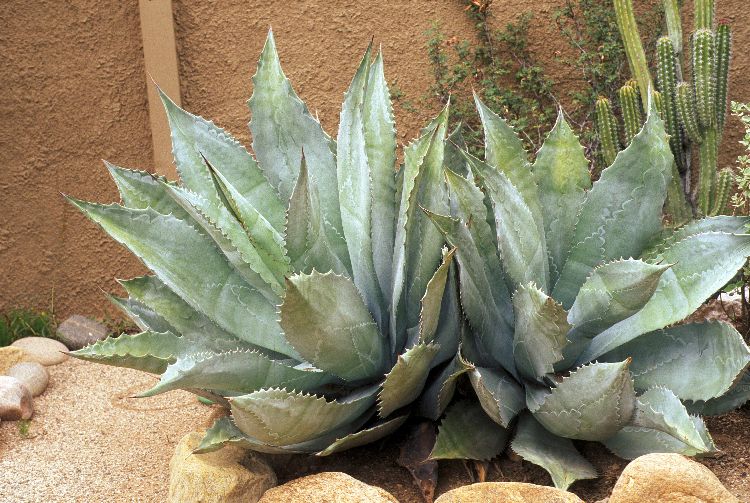
Agave colorata
Mescal Ceniza
The size of this Agave is somewhat large but at 3 feet high and as wide it is more in scale with home use than Century Plant. Markings embossed on the broad leaves add interest. Canopy coverage: 13 square feet.
[Read More]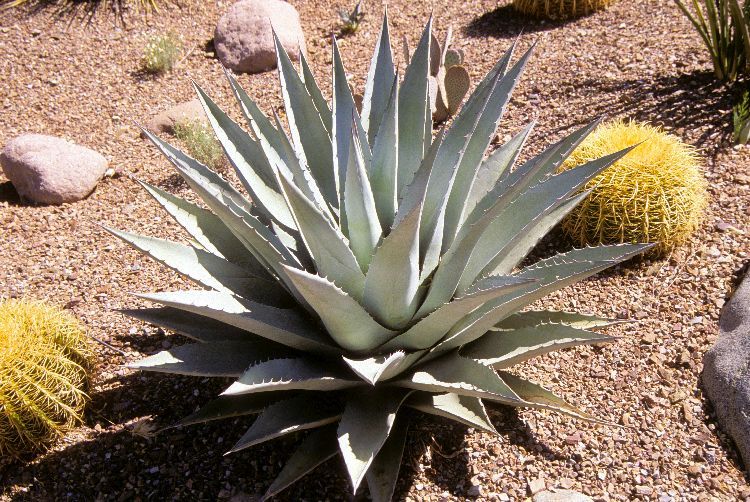
Agave desertii
Desert Agave
Desert Agave is considered the toughest Agave for its ability to grow in the hottest and most arid conditions. Plants die after blooming but plantings may continue with offsets. Flower stalk is tall and slender, reaching 5 to 15 feet high. Canopy coverage: 3 square feet.
[Read More]Agave filifera
Threadleaf Agave
Grows as a tight rosette, often in containers. Leaf blades have interesting curling threads along the edges, thus its name, and are bordered with white lines. Sharp spine at leaf tips. Flowers bloom on stalks reaching several feet high. Canopy coverage: 7 square feet.
[Read More]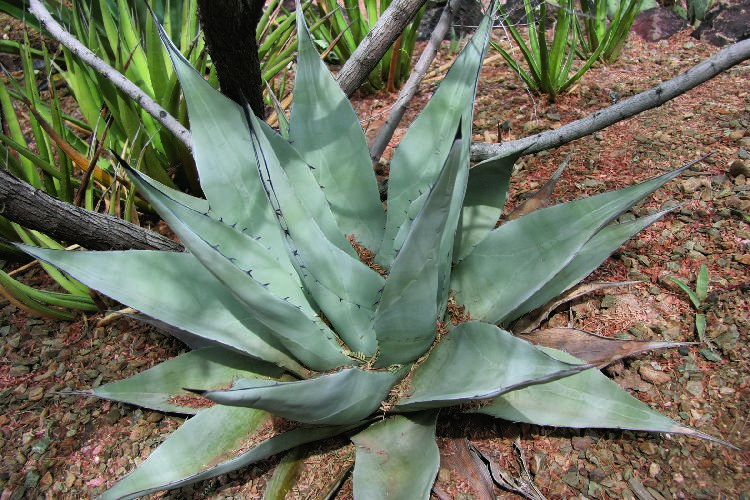
Agave havardiana
Havard Agave
The form of Havard Agave is a symmetrical, tight rosette. In hot desert regions it grows better with some afternoon shade. Canopy coverage: 7 square feet.
[Read More]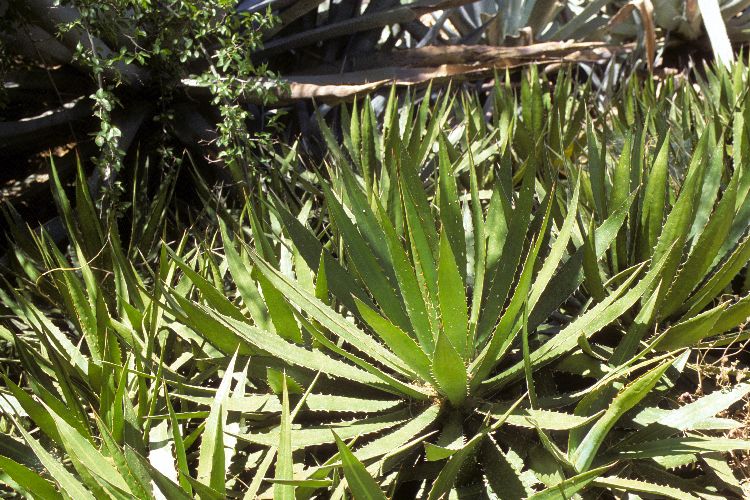
Agave lophantha
Thorn-Crested Agave, Holly Agave
This is a cluster-forming Agave that has a pleasing symmetrical growth habit. The leaves with toothed margins have a distinctive, light-colored stripe down the center. Canopy coverage: 20 square feet.
[Read More]Agave multifilifera
Chahuiqui
Grows in a dense rosette. Margins of the narrow leaves are loaded with filaments, which gives the plant a striking appearance, especially when backlit by the sun. Flower stalks reach high in the sky—to 15 feet—to show off the summer flowers. Provide a little more water in hot desert regions. Canopy coverage: 13 square feet.
[Read More]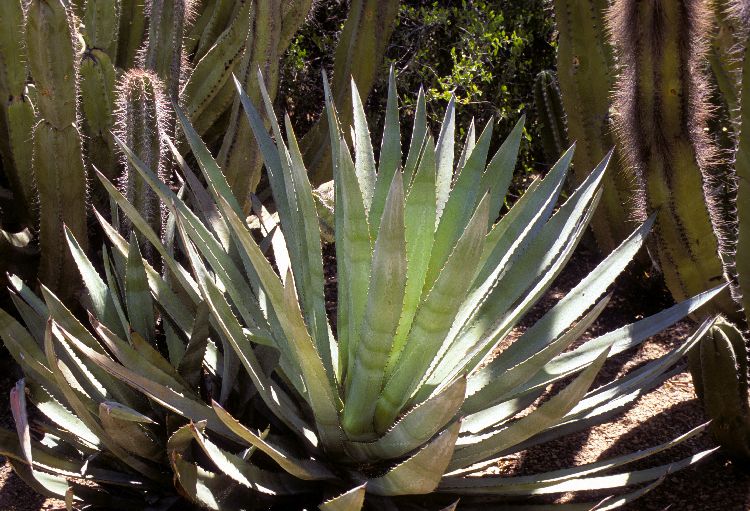
Agave murpheyi
Murphey’s Agave
Murphey’s Agave provides the same appearance and landscape use as Century Plant, but its smaller mature size is easier to manage and more versatile. With all Agaves, plants typically die after blooming. Canopy coverage: 7 square feet.
[Read More]Agave ocahui
Ocahui
A compact Agave with numerous, short, swordlike leaves, armed with a flexible but sharp spine at the leaf tips. Small stature make them a good choice for containers. Flowers bloom on a tall, 10-foot-high stalk. Leaf margins are reddish brown and can be detached from dried leaves. Canopy coverage: 7 square feet.
[Read More]Agave ovatifolia
Whale's Tongue Agave
Typically has striking bluish leaf color but can be variable. Moderate mature size makes this a choice Agave. Produces a very tall flowering stalk—to 12 feet or more. Provide with afternoon shade in low desert regions. Canopy coverage: 20 square feet.
[Read More]Agave parryi
Artichoke Agave, Parry's Agave
Artichoke Agave is one of the most decorative of all Agaves. It is worth the wait it requires to grow. As with most Agaves, plants typically die after blooming. Canopy coverage: 7 square feet.
[Read More]Agave potatorum
Butterfly Agave
This Agave grows in a rosette form with spade-shaped leaves that are armed with strong teeth and sharp spines. Locate where it will receive some shade in hot summer climates. Several selections are available—some with variegated leaves. Canopy coverage: 7 square feet.
[Read More]Agave scabra
Rough-leaved Agave
This is a common Agave in its native Chihuahuan Desert. Several subspecies can also be seen in the wild. The wide, thick leaves are edged with teeth that recurve (curve back) toward the center of the plant rosette. Sharp terminal spine. The backs of leaves have a rough texture, thus its name. Canopy coverage: 13 square feet.
[Read More]Agave schidigera
Thread-leaf Agave
Requires some TLC in desert climates; avoid planting in direct sun. Interesting fibers curl along the leaf edges. The selection 'Durango Delight' (described here) is more compact and symmetrical. Canopy coverage: 7 square feet.
[Read More]Agave schidigera 'Durango Delight'
Durango Delight Agave
This selection is a popular compact and symmetrical agave, adapted to all locations in the landscape. Leaf edges are smooth but leaf tips end in a sharp spine. Fibers add interest as they curl along the leaf edges, which are edged in white. Canopy coverage: 7 square feet.
[Read More]Agave shawii
Shaw's Agave, Coastal Agave
This Agave is dramatic in its appearance due to its prominent spines and spine colors. Upright rosette growth habit. Individual plants grow to about 2 feet wide but plantings spread due to suckers at the base of plants. Necessary to provide plants with some shade in hot desert climates. Does not like summer irrigation. Canopy coverage: 7 square feet.
[Read More]